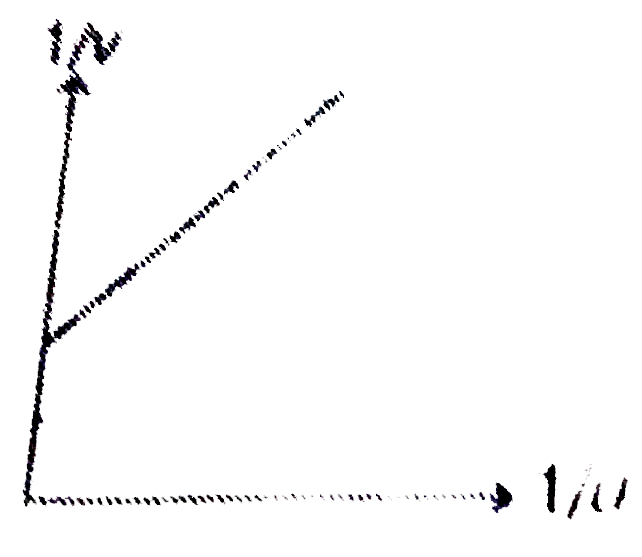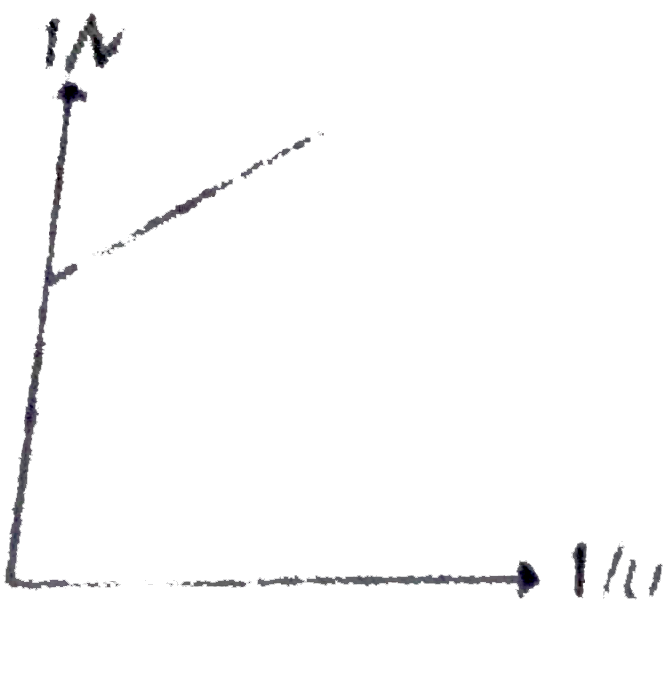An object is placed at a distance u from a concave mirror and its real image is received on a screen placed at a distance of v from the mirror. If f is the focal length of the mirror, then the graph between 1/v versus 1/u is




The correct Answer is:B
To solve the problem, we will use the mirror formula for a concave mirror and analyze the relationship between the object distance (u), image distance (v), and focal length (f).
1. Understand the Mirror Formula:
The mirror formula for a concave mirror is given by:
1f=1u+1v
2. Rearranging the Mirror Formula:
We can rearrange this formula to express 1v in terms of 1u:
1v=1f−1u
3. Identifying the Equation Type:
The equation 1v=1f−1u can be rewritten as:
1v=−1u+1f
This is in the form of y=mx+c, where y=1v, x=1u, m=−1 (the slope), and c=1f (the y-intercept).
4. Graph Characteristics:
From the equation, we see that the slope m is negative, indicating that as 1u increases, 1v decreases. This means the graph will be a straight line with a negative slope.
5. Conclusion:
Therefore, the graph between 1v and 1u is a straight line with a negative slope.
Final Answer:
The graph between 1v versus 1u is a straight line with a negative slope.
---
The mirror formula for a concave mirror is given by:
1f=1u+1v
We can rearrange this formula to express 1v in terms of 1u:
1v=1f−1u
The equation 1v=1f−1u can be rewritten as:
1v=−1u+1f
This is in the form of y=mx+c, where y=1v, x=1u, m=−1 (the slope), and c=1f (the y-intercept).
From the equation, we see that the slope m is negative, indicating that as 1u increases, 1v decreases. This means the graph will be a straight line with a negative slope.
Therefore, the graph between 1v and 1u is a straight line with a negative slope.
The graph between 1v versus 1u is a straight line with a negative slope.
Topper's Solved these Questions
- RAY OPTICSBOOK - DC PANDEY ENGLISHCHAPTER - RAY OPTICSEXERCISE - A. Only one option is correct (JEE Advance)
73 Videos
- RAY OPTICSBOOK - DC PANDEY ENGLISHCHAPTER - RAY OPTICSEXERCISE - B. More than one option is correct
20 Videos
- PROPERTIES OF MATTERBOOK - DC PANDEY ENGLISHCHAPTER - PROPERTIES OF MATTEREXERCISE - Integer
8 Videos
- ROTATIONBOOK - DC PANDEY ENGLISHCHAPTER - ROTATIONEXERCISE - (C) Chapter Exercises
39 Videos
Similar Questions
An object is placed at a distance of 30 cm from a concave mirror and its real image is formed at a distance of 30 cm from the mirror. The focal length of the mirror is
View SolutionA concave mirror forms a virtual image of size twice that of the object placed at a distance 5 cm from it . Find the focal length of the mirror.
View SolutionFor an object placed at a distance 20 cm from a concave mirror, the image is formed at the same position. What is the focal length of the mirror?
View SolutionIn a concave mirror, an object is placed at a distance d1 from the focus and the real image is formed aat a distance d2 from the focus. Then the focal length of the mirror is :
View SolutionAn object is placed in front of a concave mirror at a distance of 7.5 cm from it. If the real image is formed at a distance of 30 cm from the mirror, find the focal length of the mirror. What would be the focal length if the image is virtual.
View SolutionAn object is placed 40 cm from a concave mirror of focal length 20 cm. The image formed is
View SolutionWhen an object is placed at a distance of 40 cm from a concave mirror, the size of image is one fourth that of the object. A. Calculate the distance of image from the mirror b. What will be the focal length of the mirror?
View SolutionAn object is placed at a distance of 20 cm from a concave mirror of focal lenght 10 cm. What is the image distance?
View SolutionA convex mirror forms the image of an object placed at a distance 40 cm in front of mirror, at distance 10 cm Find the focal length of mirror.
View SolutionA convex mirror forms an image one-fourth the size of the object. If object is at a distance of 0.5 m from the mirror the focal length of the mirror is
View Solution
